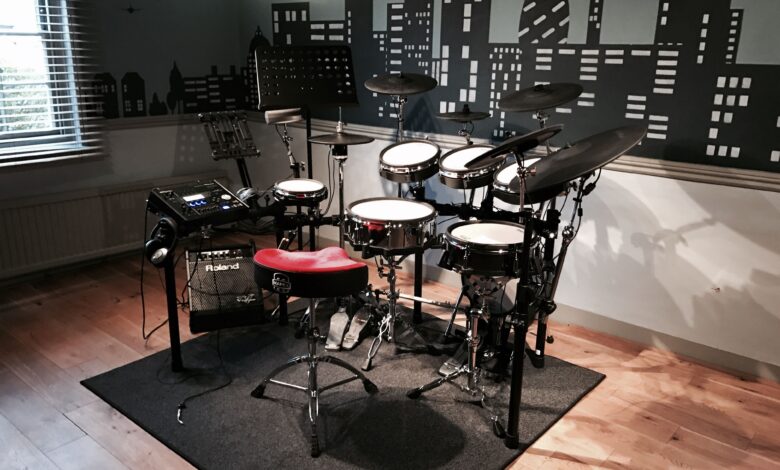The Best Electronic Drum Set for Beginners in 2023

Electronic drum set, also known as e-drums, are a type of drum kit that uses electronic sensors and triggers to produce drum and percussion sounds, rather than acoustic drums that produce sounds acoustically from being struck with drum sticks. The origins of electronic drums date back to the 1970s when early electronic drum modules and pads were first developed and commercialized.
The basic components of an electronic drum set include the drum pads/triggers, the drum module or “brain”, and the drum sounds contained in the module. The pads contain sensors that detect strikes, which then send electronic signals to the module. The module contains pre-recorded drum sounds that are triggered when the pads are struck. This allows drummers to play a wide variety of digitally produced drum and percussion sounds.
Some key benefits of electronic drums compared to acoustic drums include:
-
Volume control – Electronic drums can be played quietly with headphones for practice. Acoustic drums at full volume can be disruptive.
-
Sound versatility – Electronic modules contain a vast library of drum and percussion sounds that can be changed or customized. Acoustic drums have a fixed sound.
-
Space savings – Electronic kits take up less room than a full acoustic kit with multiple drums and cymbals.
-
Moving acoustic drums requires a large vehicle.
-
Recording integration – Electronic drums interface seamlessly with digital recording software and tools. Miking acoustic drums for recording can be challenging.
-
Price – Basic electronic drum set are more affordable than professional acoustic drum kits. Electronic drums are a cost-effective way for beginners to learn drums.
So in summary, electronic drums provide flexibility, convenience, and practical advantages compared to traditional acoustic drum kits. The digital nature of electronic drums allows drummers to shape their sound and quietly practice drums in more settings.
Types of Electronic Drum Sets
Electronic drum sets come in a few main types:
Acoustic-Electronic Hybrid Kits
Acoustic-electronic hybrid drum kits incorporate both traditional acoustic drums and cymbals alongside electronic drum and cymbal pads. The acoustic parts of the kit produce natural acoustic drum sounds, while the electronic parts trigger synthesized sounds. Hybrid kits allow drummers to get the feel of acoustic drums while also accessing electronic drum sounds.
Purely Electronic Drum Kits
Purely electronic drum kits do not include any acoustic drums or cymbals. The entire kit consists of electronic drum pads and cymbals that trigger synthesized sounds from a drum module or sound module. Without acoustic drums, these kits take up less space and allow for quiet practice and recording scenarios.
Digital vs Analog
Earlier electronic drum set used analog circuitry to generate sounds. Modern electronic kits largely rely on digital samples and synthesis for producing drum and percussion sounds. Digital kits offer more versatility, higher sound quality, and a wider range of drum tones.
Drum Pads and Triggers
Electronic drum pads use sensors and triggers to detect hits. When struck, the pads send signals to the drum module to play corresponding sounds. Drum pads come in various styles including rubber pads, mesh-head pads, and pad sets emulating acoustic drums. The sensitivity of the triggers affects the playability and response.
Electronic Drum Sounds and Samples
One of the most important aspects of an electronic drum set is the sounds and samples it can produce.
Most electronic drum modules come preloaded with a library of drum kit sounds and individual percussion/cymbal sounds. These are created by extensively sampling acoustic drums and cymbals, then editing and processing the sounds. Higher-end modules may have hundreds or even thousands of drum samples for everything from pop to jazz to heavy metal genres.
In addition to prerecorded samples, drum modules use synthesis to generate electronic drum sounds. These are less realistic than samples, but allow for more customization and unique tones. For example, 808-style synthesized bass drums are common in electronic music. The mix between sample-based and synthetic sounds affects the realism and flexibility of the drum set.
An advantage of electronic drums is the ability to customize and expand sounds by adding new drum sample packs. This allows you to tailor the set to your musical needs, or even replicate the kits of famous drummers. Some modules include USB ports to transfer sounds from a computer. It’s also possible to assign multiple samples to each pad, allowing you to switch sounds in real-time.
When selecting an electronic drum set, it’s worth considering the quality and variety of built-in sounds, as well as the ability to customize with new samples. If realism is desired, focus on sample-heavy modules over synthesized sounds. But synthetic drums can be useful for certain genres. Having an array of both realistic acoustic drums and electronic tones provides the most flexibility.
Electronic Drum Modules
The electronic drum module is essentially the brain of the entire electronic drum kit. This module controls all of the drum and cymbal sounds, trigger sensitivity, effects, and more. There are two main types of modules – standalone and integrated.
Standalone modules are separate components that drums and cymbals plug into. These give you more flexibility in setup and allow you to use modules from different brands with your drum kit. Integrated modules are built into the drum rack itself, creating a more seamless all-in-one kit.
High-end modules give you access to a wider range of drum and percussion sounds through increased memory and sampling rates. For realistic acoustic drum sounds, look for modules with multi-layered samples. Other advanced features include built-in sequencers, USB connectivity, individual outputs, and effects like reverb, compression, and EQ.
The sounds in a module can make or break an electronic kit. Look for kits with hundreds to thousands of quality drum and cymbal sounds from real acoustic drums. Good modules have natural dynamics that respond to your playing technique and expression.
Triggering Modes and Sensitivity
Electronic drums use different triggering modes and sensitivity settings to detect drum hits and convert them into electronic sounds. This allows drummers to customize the playability and response of the kit.
Single, Dual, and Triple Zone Pads
-
Single zone pads have one sensor that detects the entire surface of the drum or cymbal. These offer basic triggering with less playing articulation.
-
Dual zone pads have two sensors – one for the head and one for the rim. This allows different sounds to be assigned to the head and rim shots.
-
Triple zone pads have three sensors that detect head, rim, and bell hits. This provides more articulation options and realistic cymbal choking effects.
Piezo Sensors and Mesh Heads
Most electronic drums use piezo sensors below the pad surface to detect vibrations from hits. Some drums use specialized mesh heads with the piezo triggers built in.
Mesh heads bounce and respond more like acoustic drums. The tension is adjustable to change rebound and feel.
Adjustable Sensitivity and Threshold
Electronic modules allow adjusting the trigger sensitivity and threshold. Higher sensitivity picks up soft hits and ghost notes. Higher thresholds reduce mis-triggers.
This allows drummers to dial in the perfect response for their playing style – from light jazz to heavy metal.
Crosstalk Avoidance
Crosstalk occurs when vibrations trigger other pads accidentally. Modules use audio filtering and crosstalk suppression to avoid this.
Pads can be tuned individually to reject frequencies from other drums/cymbals. This prevents false triggering and makes kits more dynamic.
Electronic Drum Heads
Electronic drum set can use rubber pads or mesh heads for the drum sounds. Rubber pads generally provide more rebound and a harder feel, while mesh heads aim to emulate the response of an acoustic drum head.
Mesh drum heads are often considered closer to the feel of real acoustic drums. The tension of mesh heads can be adjusted to change the rebound and response, similar to tuning an acoustic drum. Some high end electronic kits use real acoustic drum hoops and standard drum key tuning, while others use proprietary tuning mechanisms.
The advantage of mesh heads is the adjustable bounce and realistic feel compared to rubber. The downside are they can be prone to denting or tearing with extremely hard playing. Rubber pads don’t dent, but have a more synthetic feel.
Mesh heads are often made using a double or triple-layer woven material for increased durability. The rim size and shape also impact the feel and rebound. Some brands aim to emulate specific acoustic drum sizes and types with their mesh heads.
Overall, mesh heads provide a great balance of realistic acoustic drum response and the durability required for an e-kit. With proper care, high quality mesh heads can last many years and provide a great playing experience.
Special Electronic Cymbals
Electronic drum set use special cymbals and hi-hats to mimic the nuances and expressiveness of acoustic cymbals. Here are some of the key cymbal types:
Choke-able Cymbals
Choke-able cymbals allow drummers to “choke” or mute the cymbal by grabbing it, similar to an acoustic cymbal. This cuts off the sustain and creates a realistic choking effect. Electronic cymbals like the Roland CY-5 and the Yamaha PCY135 feature choke capability.
Acoustic-Modeling Cymbals
These cymbals aim to recreate the complex overtones and harmonics of real cymbals. They have multiple trigger zones and advanced modeling technology to produce a very realistic sound. The Roland V-Cymbal and Yamaha DTX pads are examples of acoustic-modeling cymbals.
Hi-Hat Controllers
Electronic hi-hats consist of a hi-hat top cymbal pad and a hi-hat control pedal. The pedal allows drummers to control the sound of the hi-hat, opening and closing it like an acoustic hi-hat. This creates realistic chick, splash, and sizzle sounds.
Other Effects Cymbals
There are electronic cymbals designed for special effects rather than drum kit use. For example, the Roland CY-12C crash has a reverse cymbal sound, while the CY-13R ride can swell from soft to loud when choked. This expands the creative possibilities.
In summary, electronic cymbals are highly advanced, providing drummers with the nuanced expression and realism needed for professional playing. The latest cymbal pads borrow acoustic principles for unmatched dynamic control.
Notable Electronic Drum Brands
Electronic drums have been around since the 1970s, with certain brands rising to the top over the decades. Here are some of the most well-known and popular electronic drum brands on the market:
Roland
Roland is one of the pioneers and leading innovators in electronic drum kits. Their V-Drums line has become an industry standard, known for excellent sound quality, dynamics, and durability. Roland offers electronic kits for all skill levels and budgets, from flagship professional kits like the TD-50 to affordable home kits like the TD-1. They are constantly developing new sound modeling technology for incredibly realistic acoustic drum sounds.
Yamaha
Another heavyweight, Yamaha has made major contributions to electronic drum kit technology and manufacturing. Their DTX line provides a wide selection of digital drum sets for practice, performance, and recording. Yamaha is known for the natural feel and playability of their drum pads and pedals, as well as the deep editing capabilities of their drum modules.
Alesis
Alesis specializes in budget electronic drum kits, making digital percussion more accessible to beginners and hobbyists. While not as advanced as Roland or Yamaha, Alesis kits offer decent sounds and features at affordable prices. Popular Alesis drum set series include the Nitro, Surge, Command, and Crimson.
Simmons
Simmons were pioneer of electronic drums in the 1980s. After fading away for some time, they made a comeback in recent years with innovative new electronic kits with mesh heads, ample trigger outputs, and versatile modules. Simmons kits strike a balance between modern features and classic vintage electronic drum sounds.
ddrum
ddrum has carved out a niche for high-end but more affordable electronic drum set aimed at working drummers. They use quality components and have a reputation for ruggedness and reliability. ddrum kits offer professional features and performance for gigs and the studio.
The major brands each have their strengths and differences in terms of sound, feel, features, and price points. With so many options available today, drummers can find an electronic kit tailored to their needs and budget. The competition has driven innovation and improved quality across the market.
Connecting to a PA System
Electronic drum set need to be connected to a PA system or amplifier to be heard in a live performance setting. There are two main ways to connect:
Line Out and USB Ports
Most electronic drum modules have a line out or headphone jack to connect directly to a PA system or powered monitor speakers. Higher-end modules may also have a USB port or MIDI out to connect to a computer and process the drum sounds through music software. The line out provides the master stereo output of the drum module.
Using a DI Box
For the best sound quality, it’s recommended to use a DI (direct injection) box between the drum module line out and the PA system. A DI box converts the unbalanced line level output to a balanced mic level signal, which helps reduce noise over long cable runs and provides better impedance matching with the PA system. Make sure the DI box can handle line-level signals.
Incorporating Electronic Drums in Live Shows
Electronic drums are commonly used in live performances, especially for drummers who want access to a wide range of drum sounds and effects. The drums need to be set up on stage just like an acoustic kit, with all cables secured and labeled. Monitor mixes are important so the drummer can hear the drum sounds. The stereo line out can be connected to the PA or to a keyboard amplifier on stage. Sound engineers will mic the drum set to amplify the acoustic trigger sounds from the drum pads and cymbals. This combines with the line out for a natural, mic’d drum sound.
Pricing and Buying Considerations
Electronic drum set can vary greatly in price, from entry-level models under $500 to professional kits costing over $5000. Here are some key factors to consider when shopping for an electronic drum set:
Entry-Level vs Pro Models – Entry-level e-drum sets usually have rubber pads, limited sounds/kits, and more basic drum modules. Pro-level sets have realistic mesh heads, large sample libraries, and advanced modules with more control options. Expect to pay $800+ for a mid-range kit and $2000+ for a high-end professional kit.
Acoustic Shells vs Rack Systems – Acoustic shell sets emulate a real drum look and feel. The pads are mounted to regular drum hardware in a shell. Rack systems have pads mounted to a metal frame, taking up less space but not looking quite as much like acoustic drums. Shell sets cost more but provide a more realistic playing experience.
Accessories and Add-ons – Consider extras like drum thrones, pedals, headphones and audio interfaces. Look for kits that support add-on pads and cymbals for future expansion. High-end modules allow importing new sounds and samples. Expect to spend $500+ for extra cymbals, pads, etc.
Used vs New Market – Buying used can save substantially, but limits options. Check used markets like Craigslist and Reverb.com for deals, but make sure to test gear thoroughly before purchasing. Buying new gives you the full warranty and latest gear.





